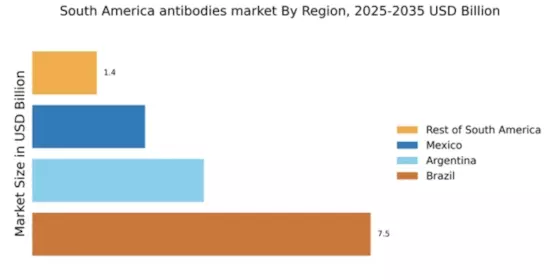Supportive Government Policies
Supportive government policies in South America are playing a pivotal role in shaping the antibodies market. Governments are increasingly recognizing the importance of biotechnology and biopharmaceuticals in improving public health. Initiatives aimed at fostering innovation, such as tax incentives and funding for research projects, are being implemented to stimulate growth in the antibodies market. For instance, several countries in the region have established regulatory frameworks that facilitate the approval of new antibody therapies, thereby accelerating their entry into the market. This supportive environment encourages both local and international companies to invest in antibody research and development. As a result, the antibodies market is likely to experience enhanced growth, driven by a favorable policy landscape that promotes innovation and accessibility to advanced therapies.
Growing Biopharmaceutical Sector
The biopharmaceutical sector in South America is experiencing rapid growth, which serves as a significant driver for the antibodies market. With an increasing number of biopharmaceutical companies emerging in the region, there is a rising demand for monoclonal antibodies and other antibody-based therapies. The market for biopharmaceuticals is expected to reach approximately $30 billion by 2026, reflecting a compound annual growth rate (CAGR) of around 10%. This growth is fueled by the need for innovative treatments for various diseases, including cancer and infectious diseases. As biopharmaceutical companies invest in research and development, the antibodies market is likely to benefit from increased production and availability of novel antibody therapies. This trend highlights the interdependence between the biopharmaceutical sector and the antibodies market, driving advancements and expanding treatment options for patients.
Advancements in Diagnostic Technologies
Technological advancements in diagnostic tools are significantly influencing the antibodies market in South America. Enhanced diagnostic capabilities enable earlier detection of diseases, which is essential for effective treatment. The integration of antibodies in diagnostic assays, such as ELISA and Western blotting, has improved the accuracy and speed of disease identification. As healthcare providers increasingly adopt these advanced diagnostic methods, the demand for specific antibodies is expected to rise. Furthermore, the market for diagnostic tests is projected to grow at a CAGR of around 8% over the next five years, indicating a robust opportunity for antibody manufacturers. This trend not only enhances patient outcomes but also drives the antibodies market by creating a need for a diverse range of antibody products tailored for various diagnostic applications.
Rising Demand for Personalized Medicine
The increasing focus on personalized medicine is emerging as a key driver for the antibodies market in South America. Personalized medicine aims to tailor treatments based on individual patient characteristics, which often involves the use of specific antibodies. As healthcare providers seek to improve treatment efficacy and minimize adverse effects, the demand for targeted antibody therapies is expected to rise. This trend is supported by advancements in genomics and proteomics, which enable the identification of biomarkers for various diseases. The personalized medicine market is projected to grow at a CAGR of approximately 12% over the next few years, indicating a robust opportunity for antibody developers. This shift towards personalized approaches in healthcare not only enhances patient outcomes but also propels the antibodies market, as more tailored therapies become available.
Increasing Prevalence of Chronic Diseases
The rising incidence of chronic diseases in South America is a crucial driver for the antibodies market. Conditions such as diabetes, cancer, and autoimmune disorders are becoming more prevalent, leading to a heightened demand for effective therapeutic solutions. According to recent health statistics, chronic diseases account for approximately 60% of all deaths in the region. This alarming trend necessitates the development and commercialization of innovative antibody therapies, which are often more targeted and effective than traditional treatments. As healthcare systems strive to manage these diseases, investments in research and development of antibodies are likely to increase, thereby propelling the antibodies market forward. The growing burden of chronic diseases underscores the urgent need for advanced treatment options, positioning the antibodies market as a vital component of the healthcare landscape in South America.


















Leave a Comment